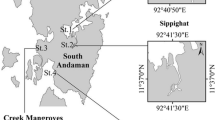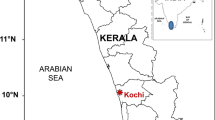Abstract
Microphytobenthos (MPB) plays an integral role in contributing to the productivity and sustenance of shallow marine ecosystem. MPB forms an integral component in the trophic structure of mangrove forest and its biogeochemistry. Microphytobenthos from three selected mangrove ecosystems (S1, Kannur; S2, Kochi and S3, Kollam) along the southwest coast of India was studied in detail for 1 year (2018–2019). Spatial and temporal (seasonal) variations in the community structure were addressed along with major environmental factors influencing the pattern of distribution. A total of 148 species of microphytobenthos under 58 genera were identified during the study. Diatoms (Bacillariophyceae) were the most abundant and diverse class of MPB present followed by Cyanophyceae, Dinophyceae and Euglenophyceae. The analysis of physicochemical parameters showed that salinity, temperature, sediment texture and nutrient characteristics were the major factors governing the community structure of MPB. Seasonally, maximum abundance was observed during monsoon and pre-monsoon with lesser diversity and extensive mats of cyanobacteria dominated by Oscillatoria spp. However, post-monsoon season with high nutrient concentration, increased salinity and more of sandy sediment texture supported diverse assemblage of diatoms. Dominant diatoms observed were Amphora spp., Diploneis sp., Navicula spp., Nitzschia spp., Pleurosigma sp. and Gyrosigma sp. Regionally, S3 Kollam was observed to be more diverse with the dominance of diatoms, whereas S2 Kochi observed lesser diversity with cyanobacterial dominance. Increased sediment grain size (sand ~ 68%) favoured diverse diatom assemblage at S3 resulting in an overall high MPB diversity of the area than S1 and S2.







Similar content being viewed by others
References
Al-Yamani, F.Y., and M.A. Saburova. 2011. Illustrated guid on the benthic diatoms of Kuwait’s marine environment. Kuwait: Kuwait Institute for Scientific Research 352 pp.
Amspoker, M.C. 1977. The distribution of intertidal epipsammic diatoms on Scripps Beach, La Jolla, California, USA. Botanica Marina 20 (4): 227–232.
Badarudeen, A., K.T. Damodaran, K. Sajan, and D. Padmalal. 1996. Texture and geochemistry of the sediments of a tropical mangrove ecosystem, southwest coast of India. Environmental Geology 27 (3): 164–169.
Banerjee, L.K., A.R.K. Sastry, and M.P. Nayar. 1989. Mangroves in India, identification manual. Govt. of India: Botanical Survey of India.
Blasco, F. 1975. The Mangroves in India (translated by Mrs. K. Thanikaimoni from LES MANGOVES DE L’INDE), Institute Francais de Pondicherry, Inde, Shri Aurobindo Ashram, Pondicherry, India.
Bouillon, S. 2011. Carbon cycle: storage beneath mangroves. Nature Geoscience 4 (5): 282–283. https://doi.org/10.1038/ngeo1130.
Burkholder, J.M., D.A. Dickey, C.A. Kinder, R.E. Reed, M.A. Mallin, M.R. McIver, and N. Deamer. 2006. Comprehensive trend analysis of nutrients and related variables in a large eutrophic estuary: a decadal study of anthropogenic and climatic influences. Limnology and Oceanography 51 (2): 463–487.
Dick, G.J., S.L. Grim, and J.M. Klatt. 2018. Controls on O2 production in cyanobacterial mats and implications for earth’s oxygenation. Annual Review of Earth and Planetary Sciences 46 (1): 123–147. https://doi.org/10.1146/annurev-earth-082517-010035.
Donato, D.C., J.B. Kauffman, D. Murdiyarso, S. Kurnianto, M. Stidham, and M. Kanninen. 2011. Mangroves among the most carbon-rich forests in the tropics. Nature Geoscience 4 (5): 293–297. https://doi.org/10.1038/ngeo1123.
Du, G.Y., and I.K. Chung. 2007. Spatio-temporal variation of intertidal microphytobenthos in the Nakdong Estuary. Journal of the Korean Society of Oceanography 12: 186–190.
Folk, R.L. 1974. Petrology of sedimentary rocks: Austin, 182 p. Hemphill: Texas.
Goto, N., O. Mitamura, and H. Terai. 2000. Seasonal variation in primary production of microphytobenthos at the Isshiki intertidal flat in Mikawa Bay. Limnology 1 (2): 133–138. https://doi.org/10.1007/s102010070019.
Grasshoff, K., M. Ehrhardt, K. Kremling, and T. Almgren. 1983. Methods of seawater analysis, 419 p. Verlag Chemie: Weinheim.
Grippo, M.A., J.W. Fleeger, N.N. Rabalais, R. Condrey, and K.R. Carman. 2010. Contribution of phytoplankton and benthic microalgae to inner shelf sediments of the north-central Gulf of Mexico. Continental Shelf Research 30 (5): 456–466. https://doi.org/10.1016/j.csr.2009.12.015.
Harishma, K.M., S. Sandeep, and V.B. Sreekumar. 2020. Biomass and carbon stocks in mangrove ecosystems of Kerala, southwest coast of India. Ecological Processes 9 (1): 1–9.
Hasle, G.R., and G.A. Fryxell. 1970. Diatoms: cleaning and mounting for light and electron microscopy. Transactions of the American Microscopical Society 89: 469–474. https://doi.org/10.1017/CBO9781107415324.004.
Inoue, T. 2019. Carbon sequestration in mangroves. In: Kuwae, T. and Hori, M., Eds., Blue carbon in shallow coastal ecosystems, 73–99. Springer Singapore, 73-99. https://doi.org/10.1007/978-981-13-1295-3_3.
Kathiresan, K., and N. Rajendran. 2005. Mangrove ecosystems of Indian Ocean. Indian Journal of Marine Sciences 34 (1): 104–113.
Kolodny, Y. 1986. Hypersaline ecosystems, the Gavish Sabkha. Geochimica et Cosmochimica Acta 50 (11): 2527. https://doi.org/10.1016/0016-7037(86)90036-0.
Lopez Fuerte, F.O., D.A. Siqueiros Beltrones, and J.N. Navarro. 2010. Benthic diatoms associated with mangrove environments in the northwest region of México. Mexico: CONABIO-UABCS-CICIMAR.
Lorenzen, C.J. 1967. Determination of chlorophyll and pheopigments: spectrophotometric equations. Limnology and Oceanography 12 (2): 343–346. https://doi.org/10.4319/lo.1967.12.2.0343.
MacIntyre, H.L., R.J. Geider, and D.C. Miller. 1996. Microphytobenthos: The ecological role of the “secret garden” of unvegetated, shallow-water marine habitats. I. Distribution, abundance and primary production. Estuaries 19 (2): 186–201.
Miller, D.C., R.J. Geider, and H.L. MacIntyre. 1996. Microphytobenthos: the ecological role of the “secret garden” of unvegetated, shallow-water marine habitats. II. Role in sediment stability and shallow-water food webs. Estuaries 19 (2): 202–212. https://doi.org/10.2307/1352225.
Mitsch, W.J., and J.G. Gosselink. 2015. Wetlands, 5th edition, John Wiley & Sons, Inc., Hoboken, NJ.744 pp.
Moss, B., and F.E. Round. 1967. Observations on standing crops of epipelic and epipsammic algal communities in Shear Water, Wilts. British Phycological Bulletin 3 (2): 241–248. https://doi.org/10.1080/00071616700650101.
Nilsson, P., B. Jonsson, I. Lindstrom Swanberg, and K. Sundback. 1991. Response of a marine shallow-water sediment system to an increased load of inorganic nutrients. Marine Ecology Progress Series 71: 275–290. https://doi.org/10.3354/meps071275.
Odum, W.E., and E.J. Heald. 1975. The detritus-based food web of an estuarine mangrove community. In Estuarine research, ed. L.E. Cronin, 265–286. New York: Academic Press.
Oppenheim, D. 1991. Seasonal changes in epipelic diatoms along an intertidal shore, berrow flats, Somerset. Journal of the Marine Biological Association of the United Kingdom 71 (3): 579–596. https://doi.org/10.1017/S0025315400053169.
Paerl, H., Fulton III, R.S., 2006. Ecology of harmful cyanobacteria. In: Graneli, E., Turner, J. (Eds.), Ecology of harmful algae. Springer-Verlag, Berlin.
Pinckney, J., H.W. Paerl, and M. Fitzpatrick. 1995. Impacts of seasonality and nutrients on microbial mat community structure and function. Marine Ecology Progress Series 123: 207–216. https://doi.org/10.3354/meps123207.
Qin, B., G. Zhu, G. Gao, Y. Zhang, W. Li, H.W. Paerl, and W.W. Carmichael. 2010. A drinking water crisis in Lake Taihu, China: linkage to climatic variability and lake management. Environmental Management 45 (1): 105–112.
Raffaelli, D., J. Limia, S. Hull, and S. Pont. 1991. Interactions between the amphipod Corophium volutator and macroalgal mats on estuarine mudflats. Journal of Marine Biological Association of UK 71 (4): 899–908.
Rani, V., S. Sreelekshmi, C.M. Preethy, and S.B. Nandan. 2016. Phenology and litterfall dynamics structuring Ecosystem productivity in a tropical mangrove stand on South West coast of India. Regional Studies in Marine Science 8: 400–407.
Reddy, C.S. 2008. Field identification guide for Indian mangroves. Dehradun: Bishen Singh Mahendra Pal Singh.
Sasmito, S.D., Y. Kuzyakov, A.A. Lubis, D. Murdiyarso, L.B. Hutley, S. Bachri, D.A. Friess, C. Martius, and N. Borchard. 2020. Organic carbon burial and sources in soils of coastal mudflat and mangrove ecosystems. Catena 187: 104414. https://doi.org/10.1016/j.catena.2019.104414.
Seralathan, P., and A. Seetharamaswamy. 1979. Organic matter in the modern deltaic sediments of Cauvery river. Indian Journal of Marine Sciences 8 (1): 37–140.
Shedage, S., P.K. Shrivastava, and L.K. Behara. 2019. Carbon rich mangrove forests: an overview for strategic management and climate change mitigation. Advances in Research 18 (2): 1–9. https://doi.org/10.9734/air/2019/v18i230084.
Sreelekshmi, S., C.M. Preethy, R. Varghese, P. Joseph, C.V. Asha, S.B. Nandan, and C.K. Radhakrishnan. 2018. Diversity, stand structure, and zonation pattern of mangroves in southwest coast of India. Journal of Asia-Pacific Biodiversity 11 (4): 573–582.
Stevenson, R.J., and S. Hashim. 1989. Variation in diatom community structure among habitats in sandy streams. Journal of Phycology 25 (4): 678–686.
Stocks, K.I., and J.F. Grassle. 2001. Effects of microalgae and food limitation on the recolonization of benthic macrofauna into in situ saltmarsh-pond mesocosms. Marine Ecology Progress Series 221: 93–104.
Strickland, J.D.H., and T.R. Parsons. 1968. Determination of dissolved oxygen. A practical handbook of seawater analysis. Fisheries Research Board of Canada, Bulletin 167: 71–75.
Subrahmanyan, R. 1946. A systematic account of the marine plankton diatoms of the Madras coast. Proceedings of the Indian Academy of Sciences Section B 24 (4): 85–197.
Sundbäck, K. 1984. Distribution of microbenthic chlorophyll-a and diatom species related to sediment characteristics. Ophelia 3: 229–246.
Sylvestre, F., D. Guiral, and J.P. Debenay. 2004. Modern diatom distribution in mangrove swamps from the Kaw Estuary (French Guiana). Marine Geology 208 (2–4): 281–293.
Ubertini, M., S. Lefebvre, C. Rakotomalala, and F. Orvain. 2015. Impact of sediment grain-size and biofilm age on epipelic microphytobenthos resuspension. Journal of Experimental Marine Biology and Ecology 467: 52–64. https://doi.org/10.1016/j.jembe.2015.02.007.
Underwood, G.J.C. 1994. Seasonal and spatial variation in epipelic diatom assemblages in the Severn estuary. Diatom Research 9 (2): 451–472. https://doi.org/10.1080/0269249x.1994.9705319.
Underwood, G.J.C., and J. Kromkamp. 1999. Primary production by phytoplankton and microphytobenthos in estuaries. Advances in Ecological Research 29: 92–153.
Underwood, G.J.C., J. Phillips, and K. Saunders. 1998. Distribution of estuarine benthic diatom species along salinity and nutrient gradients. European Journal of Phycology 33 (2): 173–183. https://doi.org/10.1080/09670269810001736673.
Vinita, J., A. Shivaprasad, C. Revichandran, N.T. Manoj, K.R. Muraleedharan, and Binzy Jacob. 2015. Salinity response to seasonal runoff in a complex estuarine system (Cochin Estuary, West Coast of India). Journal of Coastal Research 31 (4): 869–878. https://doi.org/10.2112/jcoastres-d-13-00038.1.
Walkley, A., and I.A. Black. 1934. An examination of the Degtjareff method for determining soil organic matter, and a proposed modification of the chromic acid titration method. Soil Science 37 (1): 29–38.
Acknowledgements
This work was carried out as a part of UGC-SAP DRS-II project of Department of Marine Biology, Microbiology and Biochemistry, School of Marine Sciences, Cochin University of Science and Technology, Kochi-16, Kerala, India.
Author information
Authors and Affiliations
Corresponding author
Additional information
Communicated by James L. Pinckney
Rights and permissions
About this article
Cite this article
Benny, N., Thomas, L.C. & Padmakumar, K.B. Community Structure of Microphytobenthos Associated with Mangrove Ecosystems Along the Southwest Coast of India. Estuaries and Coasts 44, 1380–1391 (2021). https://doi.org/10.1007/s12237-020-00888-w
Received:
Revised:
Accepted:
Published:
Issue Date:
DOI: https://doi.org/10.1007/s12237-020-00888-w




